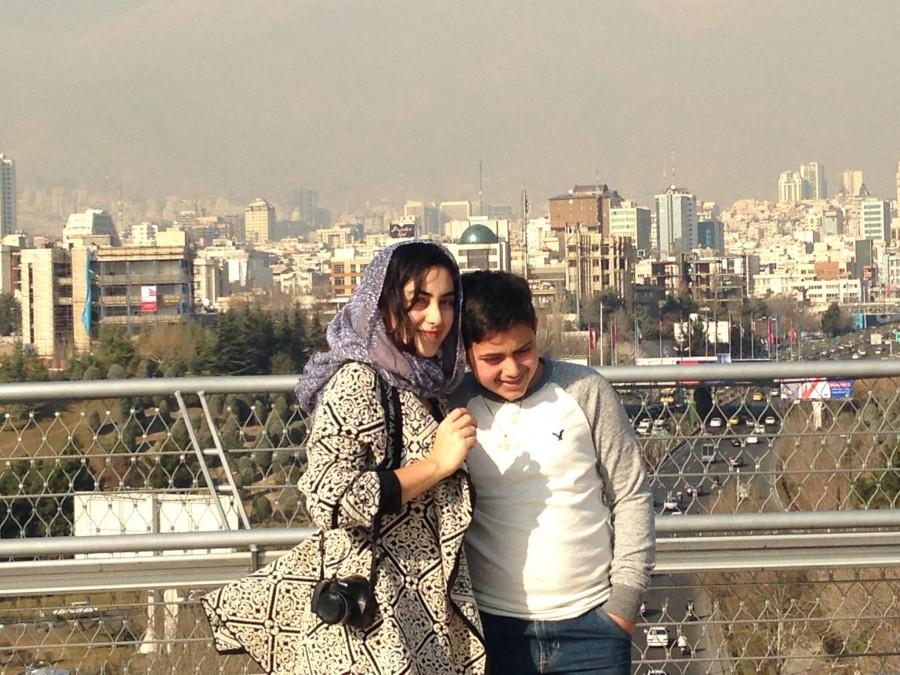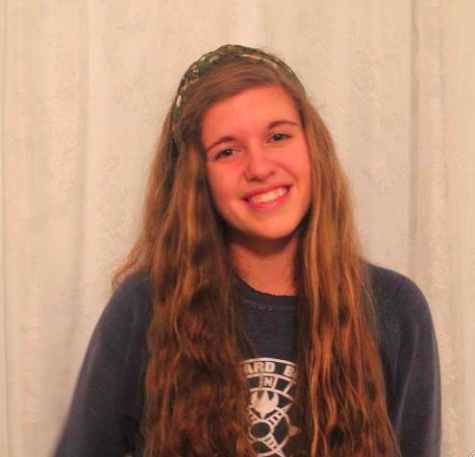Looking Forward
March 22, 2015
For most of senior Déna Dianati’s life, she relied on Skype sessions and frequent phone calls to keep in touch with her extended family, who lives in Iran – mostly in Tehran, the nation’s capital city.
This winter, however, after receiving her American citizenship, Dianati had the chance to travel with her brother and parents back to the Middle East for the first time in five years.
Although her parents were born and raised in Iran, they had moved to France in 1997, by the time Dianati was born. In 2004, the family moved to America, where Dianati has lived ever since.
In addition to the invaluable time spent with her family, Dianati was especially struck by the collision of ancient history and modern expansion that characterizes much of Iran today.
“There’s a lot of old buildings and palaces and castles which have been incorporated into the main city, so you could be going down a really urban [street], and then next to you is a garden where kings used to live 200 years ago,” Dianati said.
During their stay, Dianati also travelled to Shiraz, a city known historically as a center of the arts and literature and a capital of Persia under the Zand dynasty in the 18th century.
“That’s where Persepolis and all the ancient history of Iran is. It was amazing. It was really interesting to hear about everything we learned in history and [see it] there,” Dianati said. “And it’s still preserved after hundreds of years.”
Persepolis, located outside of Shiraz and dating back to 515 B.C., was the capital of the First Persian Empire and contains some of Iran’s oldest palaces and tombs. One relic in particular stood out to Dianati.
“They had a big staircase that represented all of the different nations that came to visit the kings, and all of the things that they offered the king,” Dianati said. “All the detail that was engraved in the stone, and everything was so symmetrical … It was magical.”
In addition to Tehran and Shiraz, Dianati visited another of Iran’s most famous cities, Isfahan, on her previous trip. Isfahan was the capital of the Safavid Empire, which ruled modern Iran into the 18th century.
“Isfahan is, I think, the most beautiful city out of all of the cities I’ve seen in Iran,” Dianati said. “It’s very green in comparison [to Tehran] … Isfahan is more open, and there’s a lot of people walking everywhere.”
Throughout the trip, the extensive heritage of Iran captivated and impressed Dianati.
“There’s a lot of history in Iran, and I don’t think people tend to see that, or to realize how old it is,” she said.
Modern life in Iran’s major cities, however, is strikingly fast-paced. Tehran and Shiraz both boast enormous markets, where woven baskets overflow with fresh fruits and rose petals, used to make tea. The streets also bustle with shopkeepers selling clothes, goods and traditional Iranian food, with which Dianati is familiar from her home in St. Louis.
“We eat Persian food a lot [in St. Louis]… kebab, lamb, rice is a huge part of Persian cuisine. We have main dishes that are mostly stews with beans or chicken … we use plums for different things. We have rice dishes that have either raisins in them or pecans and nuts,” Dianati said.
In Iranian diets, however, one spice dominates.
“Then we have saffron. It’s like gold there, it’s so valuable – and it’s expensive!” Dianati laughed. “That’s used in everything, but we use it sparingly.”
In addition to her family’s cuisine, much of Dianati’s life in St. Louis reflects her Iranian heritage.
“We only speak Farsi at home,” she said. “We’ll speak English if we make jokes, but [Farsi] is mostly what we speak. Our home is not Americanized – and, it’s not completely Persian!”
Although her family celebrates Christmas and New Year’s, for example, the Persian New Year during the spring equinox is also a beloved part of the Dianatis’ yearly traditions.
“It’s kind of like a renewal – you’re around your family and your close friends,” Dianati said.
Dianati’s return to Iran offered her a chance to immerse herself once again in the culture that defines much of her American life, as well as to see the changes in Iran that have occurred since her last visit five years ago.
Iran has traditionally been characterized as a center of religious fundamentalism since the Iranian Revolution in 1979, which deposed the American-supported shah of Iran, Mohammad Reza Shah Pahlavi, after almost two years of civil resistance and protests. Many Iranians opposed the perceived secularization and Westernization of the nation under the Shah and resented the growing influence of American money and politics.
The new government then invited Ruhollah Khomeini to return to Iran as the ayatollah, the religious leader of Iran, under a theocratic-republican constitution. Iran is a predominantly Shi’a Muslim state, a minority sect globally in comparison to Sunni Muslims, who dominate nearby Saudi Arabia and Syria.
Although there was significant popular support for the revolution, several opposition groups also emerged. The Khomeini-led government subdued many of these groups, often violently, and they instigated an extensive purge of non-Islamist opponents in which tens of thousands were executed. Many more soldiers and civilians died during the Iran-Iraq war, which broke out after Iraq invaded Iranian Khuzestan in 1980.
International organizations repeatedly criticized Iran’s government for extensive human rights violations during the war and in the years since, and Khomeini has come under fire for inflammatory comments against Western nations and minorities. Most recently, the U.S. has become increasingly wary of Iran’s suspected nuclear weapons programs.
However, some argue that significant shifts have occurred in Iran’s government during the past five years, largely due to a new president, Hassan Rouhani, who came to power in June 2013, and the ayatollah who succeeded Khomeini in 1989, Ali Khamenei. Although the degree of their commitment to reform has been questioned by some, both have been less outwardly extreme in their views and appear more open to compromise with international groups. Many have also noted a loosening in restrictions on the Iranian population, especially concerning dress and women’s rights, under Rouhani.
Dianati experienced this shift during her trip, which she believed revealed an Iran drastically different from the one commonly perceived by Westerners.
“People kind of have this stereotypical idea of the Muslim countries and Iran – that you have to have your hair completely covered, that going outside for women is completely insane and ridiculous and … that it’s not a place that you’d want to live ever,” Dianati said. “I think it’s changed a lot, and that’s something people don’t know and don’t really have access to. People don’t have the opportunity to learn about it, about how people are more open than they think, and how there’s a lot of modern culture in [Tehran]. It was really different from five years ago.”
She also witnessed several manifestations of recent reforms during her stay.
“Women didn’t wear their head scarves all the time; half the time your scarf would be falling halfway down and no one would say anything, or you’d just have a long shirt and pants on and you could walk out with sandals, your arms up to your elbows would be open. There’s a lot of new stores – brand name stores – that you didn’t see before, a lot of new cars and everything,” Dianati said.
Although these seem like small victories, Dianati saw them as indicative of a growing trend of revival in Iran.
“It’s not something major, but it’s a big deal if you’ve been living there all your life,” Dianati said. “It’s moving back to the way that it used to be – people have more rights. People have a hope for their future. Before, people didn’t want to be there, they just wanted to get out. Now people are proud of their nationality.”
In addition to internal changes, Dianati also noticed a promising opening of Iran to nearby nations and people.
“Now we have more tourists coming – you saw a lot of tourists in Tehran and Shiraz. It was surprising, and exciting. Then more people can see, more people can tell other people to come [to Iran],” Dianati said.
Although criticism of the government’s treatment of prisoners and the frequency of executions continues, the changes witnessed by Dianati seem to indicate a positive future.
Iran’s evolving political circumstances offered Dianati hope for her family’s nation, and she cherished the opportunity the trip gave her to immerse herself in Iran’s unique culture and history.
Ultimately, however, Dianati sees daily life in Iran and America as fundamentally the same.
“You get up, you go to work, you go to school, you come home, you see your family,” she said. “You just have each day.”


